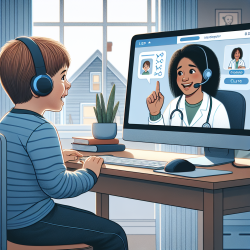Introduction
The realm of speech-language pathology continually evolves, driven by groundbreaking research and data-driven insights. A recent scoping review titled "Biomarkers for Inner Ear Disorders: Scoping Review on the Role of Biomarkers in Hearing and Balance Disorders" sheds light on the potential of biomarkers in diagnosing and managing inner ear disorders. This blog explores how practitioners can leverage these findings to enhance clinical outcomes for children and beyond.
Understanding Biomarkers in Inner Ear Disorders
Biomarkers are biological indicators that can reveal insights into disease presence, progression, and treatment efficacy. In the context of inner ear disorders, biomarkers hold promise for improving the diagnosis and management of hearing and balance issues. The review identifies key biomarkers, such as otolin-1, prestin, and matrilin-1, which can be detected in peripheral blood and are associated with inner ear pathologies.
Clinical Applications and Implications
The potential clinical applications of these biomarkers are vast:
- Diagnostic Accuracy: Biomarkers like otolin-1 and prestin can enhance the accuracy of diagnosing inner ear disorders, potentially leading to earlier intervention and better outcomes.
- Prognostic Value: The presence and levels of specific biomarkers can help predict disease progression, allowing clinicians to tailor treatment plans more effectively.
- Therapeutic Monitoring: By tracking biomarker levels, practitioners can monitor treatment efficacy and adjust interventions as needed, ensuring optimal patient care.
Encouraging Further Research
While the review highlights promising biomarkers, it also underscores the need for further research to fully understand their clinical significance. Practitioners are encouraged to engage in or support research initiatives that explore the diagnostic and prognostic potential of these biomarkers. Collaborative efforts between clinicians and researchers can lead to the development of standardized guidelines for using biomarkers in clinical practice.
Integrating Biomarkers into Practice
For practitioners looking to integrate biomarkers into their clinical practice, consider the following steps:
- Stay Informed: Keep abreast of the latest research on biomarkers in inner ear disorders. Attend conferences, participate in webinars, and read relevant journals to stay updated.
- Collaborate: Work with researchers and other healthcare professionals to explore the practical applications of biomarkers in your clinical setting.
- Educate Patients: Inform patients and their families about the potential benefits of biomarker-based diagnostics and treatments, fostering a collaborative approach to care.
Conclusion
The exploration of biomarkers in inner ear disorders represents a promising frontier in speech-language pathology. By embracing data-driven insights and fostering research collaborations, practitioners can enhance their diagnostic and therapeutic capabilities, ultimately leading to improved outcomes for children with hearing and balance disorders.
To read the original research paper, please follow this link: Biomarkers for Inner Ear Disorders: Scoping Review on the Role of Biomarkers in Hearing and Balance Disorders.










